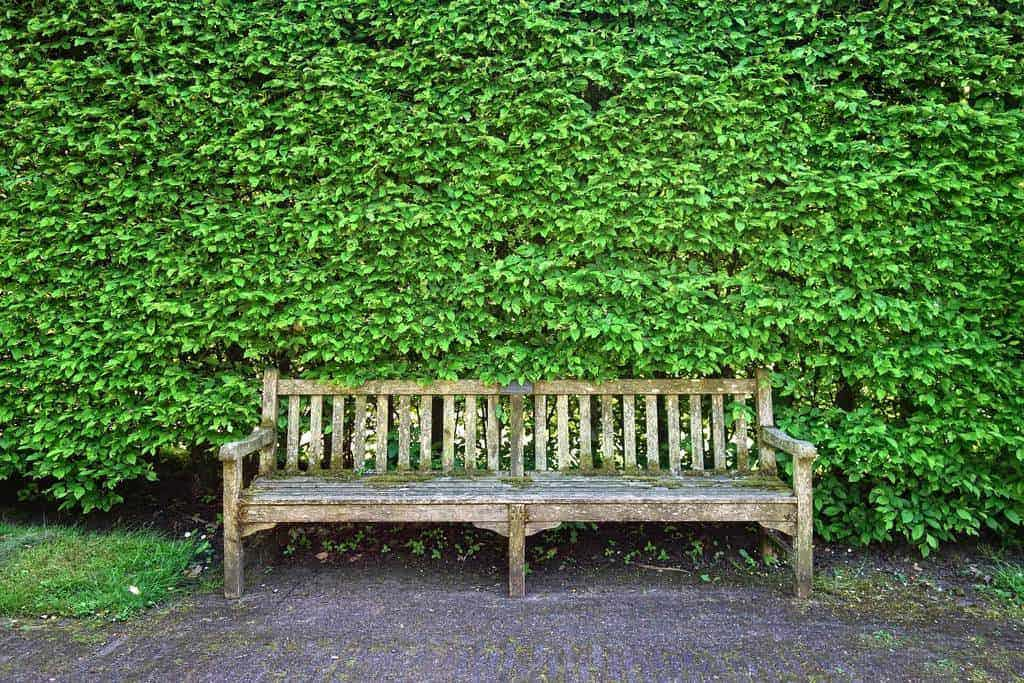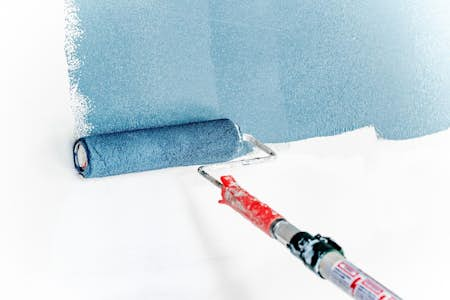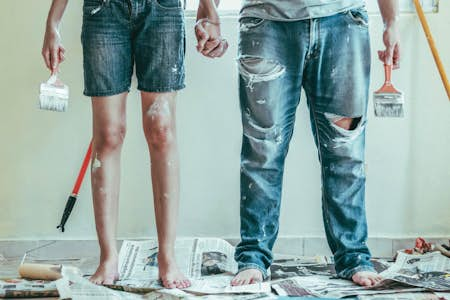Before you can truly enjoy your garden, you probably need to restore your garden furniture and give it a cleanup.
Nine months in the cold, damp, and drizzle can leave benches looking worse-for-wear and wrought iron rusty.
Rather than invest in yet another new garden furniture set, why not spend a weekend restoring what you have? It’s not as big a job as you think and you can even invite friends and family to help, with the promise of a barbecue the following week.
To get your garden ready for relaxing and entertainment, we’re going to cover:
- How to restore wooden garden furniture.
- What to do to restore wrought iron furniture.
- Restoring and caring for your rattan garden furniture.
- Cleaning up your plastic garden furniture.
How Do I Restore Wooden Garden Furniture Sets?
From Homebase garden furniture and other main brand sets to artisan or boutique pieces, wooden garden furniture is some of the most beautiful but also the most vulnerable to the elements.
You’ve spent good money on your hardwood garden furniture, and after a few years, it starts to look tired and worn - such is the inevitability of life in the British elements. Is it time to buy a new set already? You can put your credit card away and reach for the sandpaper instead.
Typical British weather can take its toll on your wooden tables and chairs, but with a bit of elbow grease, you can get your set back to its former glory.
After all, garden furniture sets are generally hard, and garden design isn’t so much about clear and clinical aesthetics - shabby chic and every rough-around-the-edges garden design trends are thoroughly in fashion.
Here’s how to go about restoring your garden furniture sets:
Step One – Be Prepared
Check the weather forecast for the days you’ll work. You need to have a couple of dry days lined up. Restoring garden furniture sets in the rain is not a pleasurable job!
Have a well-ventilated space to work in, too. Pay a trip to your local DIY shop and pick up:
- A stiff bristle brush.
- Different grades of sanding paper, from pretty coarse to rather smooth; or an electric sander.
- Teak oil or any varnish or outdoor paint you want to use.
- A paintbrush.
Step Two – Cleaning
Using your stiff bristle brush, give your wooden furniture a good brush down. Get into all the cracks, and don’t forget to turn it upside down, too. You want to have all the dust, cobwebs, and wee beasties out of the way.
Don’t be afraid of turning the hose on; you can even use a pressure washer to clean most garden furniture (not rattan), but be aware that this will take the preservative off any wood - you’ll have to re-preserve it (but we’ll be doing that anyway). Choose a warm day to allow your furniture to dry out.
Step Three – Sanding
If you like a good power tool, you might already have an electric sander in the shed or garage. You can choose to invest in one or go for the old school sweat and elbow grease method.
However you go, sand all over the wooden surfaces to get rid of any evidence of the old finish. There should be a noticeable colour change when you've got down to the original wood. Get into all the nooks and crannies, so you get an even finish later.
When sanding metal, wood or plastic, make sure you use a mask to prevent the inhalation of shavings and paint.
Step Four – Finishing
Once your furniture is back to the bare bones, it's time to add a finish to your restored garden furniture. You can either apply a layer of teak oil using a rag or a coat of varnish with a paintbrush.
Whichever you choose, apply it in the direction of the grain. Next, you’ll need to give it a couple of days to dry. If it looks like a summer shower might roll in, have a tarpaulin to throw over your restoration project.
High-quality outdoor wood varnish should always be applied to restored wooden furniture. Creosote and Ronseal are two of the leading outdoor wood varnish brands and offer high-quality weatherproof varnish in many different shades and colours.
A variety of stainers and varnishes are available from most DIY stores. You might also need to apply anti-rot wood hardeners if your wooden furniture shows signs of rotting.
What’s the Process to Restore Wrought- or Cast-Iron Garden Furniture?
Your metal garden furniture should be pretty hardy against the elements. Even cheap garden furniture made from metal is tough and waterproof, but you will inevitably find signs of rust over the years.
Rusted and weathered material is a garden design trend in itself, so choosing to do nothing is more than valid! You might just need to tighten the screws, nuts and bolts of your metal garden furniture.
You’ve got two options when the rust sets in on your iron garden furniture:
- Patch it up by removing the rust with wire wool and repaint the area with enamel paint to match the current colour.
- Strip off all the paint with a chemical dip. Take your furniture along to your local paint stripping location to remove all the paint. When you get it home, wire wool off any rust and repaint with Hammerite or a similar metal paint suitable for the outdoors.
How Do I Restore My Natural Garden Furniture Sets?
Whether you own boutique pieces or reliable Homebase garden furniture, garden furniture sets made from natural material are slightly harder to restore.
Hopefully, you remembered to bring in the cushions before last autumn set in! Rattan and other woven garden furniture need to be stored properly - invest in a quality cover to protect your sets over the colder months.
When your woven garden furniture has spent the winter outside, it’ll likely have accumulated some dirt and debris in hard to reach places.
Rattan is another semi-natural garden furniture material that can show signs of wear.
Give your garden furniture sets a hose down and a going over with a soft bristle brush, then let them dry in the breeze. If you want to restore your synthetic rattan furniture, this is as much as you need to do – just put the cushions back out. You may notice rattan furniture losing its colour; you can buy specific stainer and paint designed for rattan furniture.
For natural rattan garden furniture, you can also revamp it with colour by using spray paint. After cleaning, spray on a coat of primer and leave it to dry according to the instructions. Next, spray your rattan furniture with an even coat of good quality spray paint. You’ll probably need to build up a few layers to get the effect you want.
More thin coats are better than fewer thick coats. It’s essential to wear a mask while spray painting garden furniture.
What Can I Do to Restore Plastic Garden Furniture?
Plastic is an excellent material for cheap garden furniture.
Buying plastic garden furniture can be a good investment if you’re aiming for low maintenance. Good quality plastic chairs and tables should see you right over plenty of summers, although they may lose some colour through the years.
Each year, wipe your plastics over with warm, soapy water. Don't forget to get underneath – this is where muck and cobwebs can build up if left alone. If your plastic garden set is pretty sturdy, a low setting on your pressure washer could also do the trick. Who doesn’t like an excuse to get the pressure washer out?
How to restore cheap garden furniture?
Does it need to be restored? Does it still look good?
So long as it looks good and you can sit on it, cheap garden furniture can be left alone - it’s part of its charm. Any garden furniture that is dodgy or dangerous to sit on needs attention, but so long as structural integrity is maintained, you might not need to do much.
When garden furniture restoration becomes DIY
Sometimes, simple restoration just isn’t enough to rescue a piece.
There is hope - wooden garden furniture, in particular, can often be rescued with some DIY.
If the wood has rotted, then you can treat it with an anti-rot wood hardener. This is only suitable when the wood itself is thick and robust enough to support the chair. If it’s wearing all the way through or the chair’s structural integrity is otherwise compromised, you’ll need to consider other options.
It might be possible to add wooden reinforcement, either screwing, nailing or glueing a support joist across the rotted joint.
It’s also possible that screws loosen in your garden furniture as it expands and contracts from the heat and wet. This can widen the holes that your screws grip to. Consider using wood filler or wood glue to tighten the joins.
If repair or restoration just isn’t possible - if your garden furniture has passed the point of no return - then consider choosing some new garden furniture.
Garden design tips: keep it shabby chic
Garden furniture can look great when weathered. Regardless of whether you’ve got metal, wood, plastic or rattan garden furniture, light weathering can add charm and character. That said, heavy weather is much easier to stomach with cheap garden furniture.
When it comes to more expensive wooden and rattan pieces, you’d certainly be forgiven for your anger when uncovering heavily worn or rotten furniture!
Upcycle as you restore
Why not go one step further and
Safety First
It's essential to do things the right way when you're restoring your garden furniture. By default, most of your work will be outdoors, but you still need to protect yourself from hazards like dust and paint fumes. Watch out for loose nails and splintered wood. Splintered rattan can be nasty too.
- Wear a mask when you’re sanding wood or using varnishes or paint – ask at the DIY shop when you buy your sandpaper and varnish, so you get the right mask for your needs.
- Wear gloves when using wood stainers, varnishes, paint or any other form of wood treatment. Wood treatments can be very irritable to the skin - it’s not worth risking.
- Get into your scruffs; you never know when a stray nail could rip your jeans or paint could get spilt.
- Have a back-up space to put your garden furniture restoration project in case a summer shower rolls in to dampen your day. Make space in the garage or have a waterproof cover handy.
Getting to work restoring your garden furniture
Having outside space when the weather is nice is a blessing. To enjoy it properly, you want to get your garden furniture in good shape. There’s no need to go and invest in yet another set of tables and chairs; look over what you’ve already got and see if a weekend’s worth of handiwork can bring things back to life.
Most types of garden furniture can be rescued with a bit of effort. Bring the younger generations round to do the hard work and reward them with long lazy afternoons in your garden for their good deed!









